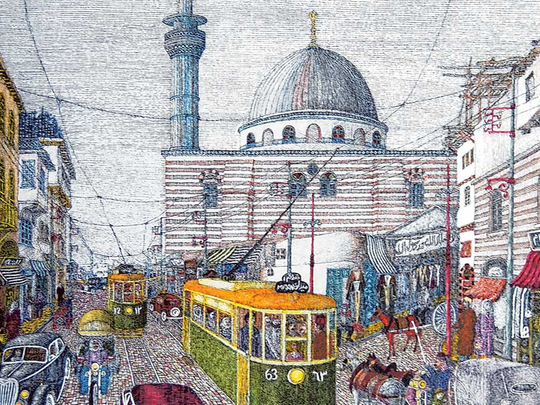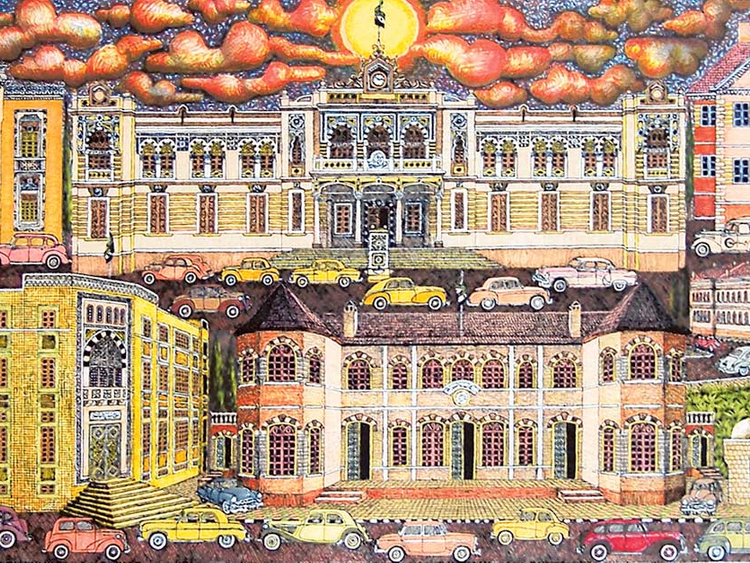
Those who have seen Damascus in the good old days are sure to get goose bumps when they look at the drawings and woodcuts in Khaldoun Chichakli’s first solo show in Dubai, “Damascenes”. And even those who have not been there will be overwhelmed by the beauty and history of the city that comes through so clearly in the artworks.
The septuagenarian artist has lovingly recreated minute details of the city’s architecture, everyday scenes on the streets and souks, and the ethos of the place as it was during his childhood and youth. Amid the destruction and devastation wrought by the political turmoil in his country, Chichakli’s artworks are a poignant reminder of a bygone era.
In his intricately detailed woodcuts, the artist has created delicate lines using the techniques and tools of the diamond cutters of Belgium, where he studied and lived in the 1980s. The works depict rural life in Syria, vendors in the souk, the various stages and experiences in the journey of life, and a look at what happens behind the walls in a city.
“When I was invited to exhibit my work in Belgium, these subjects came to me spontaneously because I was missing my family and my country, and I wanted to show the people there the beauty, rich culture and artistic heritage of Syria,” Chichakli says.
The artist has also dealt with abstract themes, such as love, fear, exile and life as a game of chess, and voiced his anger about the exploitation of women in the name of religion. Also included is a woodcut depicting an ancient Christian village in the mountains of Syria that was destroyed during the present conflict.
Chichakli, who is a professor at the Fine Arts University in Damascus, first began making pen and ink drawings of the city centre from memory as a way to while away the tedium of proctoring examinations. He uses the “tahsheer” method of first drawing fine lines and then going over them repeatedly to darken an area. He then colours scanned prints of the black and white drawings to depict the same scene at different times of day and night. The colouring is also done by careful layering of inked lines and not with a brush.
“I use this technique because I am a graphic artist and not a painter. But I feel that unlike the cold black you would get with a brush, the black I create with my lines has warmth, just like my country. This method requires a lot of time and a small mistake can ruin the entire work, but I have the patience and my love for my city keeps me going,” he says.
The artist has done several drawings of Damascus Square in the old days, showing the buildings, monuments and the cars, buses, trams, and horse carts on the cobbled streets. The amazing details range from tiny elements of the architecture to the people inside the vehicles. In his drawings of Hamidiya bazaar, he has recreated the hustle and bustle of the place, the signage on the shops, and even the patterns on the carpets and textiles displayed in the shops.
Other nostalgic drawings bring alive his memories of the tree-lined streets along River Barada, the mountains in the background, families picnicking on the banks, and even a message etched on the mountainside long ago by a jilted lover. Ali Pasha bazaar and the vendors on the streets outside, Noufara Square with its famous café, the area around Al Sananeah Mosque, and the special lighting on Government Street in old Damascus during Independence Day celebrations are among the other memories he has shared.
“I want to show people how beautiful, calm and clean the city was. Today Hamidiya bazaar is so crowded, dirty, noisy and disorganised that you cannot appreciate the beauty of the architecture and the ambience of the market. In the old days we could drink water directly from Barada, but now the river is stinking with animal carcasses floating in the water,” Chichakli says.
Many of his drawings feature buildings and structures that do not exist today, such as the Victoria Hotel, the iron bridge connecting the hotel to the railway station across River Barada, and a building constructed by Ottoman ruler Jamal Basha. These works speak about the colonial history of the city, and the callous renovations and demolitions done in the name of progress and modernisation.
“The Victoria Hotel and bridge were built in the late 19th century and named after Queen Victoria in anticipation of her visit. The French later reinforced the bridge with stone to transport military equipment. Queen Victoria never came to the city, and the bridge and hotel were later demolished. Now a really ugly building stands in its place. The Ottoman building was one of the few cement buildings at the time and was very beautiful, but now exists only in my memory,” the artist reminisces.
His passion is such that he makes six different versions of every drawing. He does a night version of the original black and white drawing, where the clouds are replaced by a starry sky. He also does coloured day and night versions; a romantic depiction of the scene at sunset; and finally a dreamy abstract visualisation of the landscape.
The buildings and people seemingly frozen in time beneath the changing colours and moods of the artworks speak about the artist’s anguish at what is happening to his city today. “As I sit in my house, thinking about the Damascus of my memories and dreams, I can hear the sounds of the war raging outside. I am so worried that my city may be destroyed, and I hope and pray that this does not happen,” he says.
Jyoti Kalsi is an arts enthusiast based in Dubai.
“Damascenes” will run at Green Art Gallery, Al Quoz until June 27














